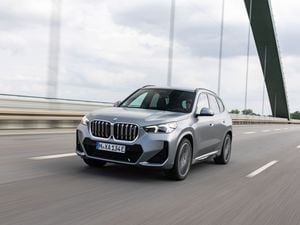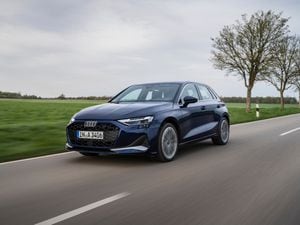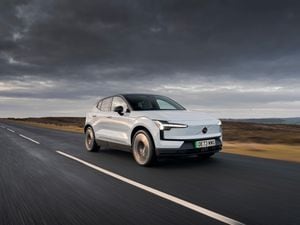Prototype Drive: The BMW iX1 arrives as the German firm’s new ‘entry-level’ electric SUV
The iX1 will be the latest model in BMW’s EV line-up. Ted Welford tries a prototype version ahead of a 2023 launch.

What is it?

The BMW i3 will go down in history as one of BMW’s icons. Arriving in 2013, it was well ahead of its time, with a highlight being an interior made largely from recycled materials – an idea many manufacturers are only just waking up to a decade later.
It was a further seven years before BMW launched another EV, but the brand is now ramping up its electric line-up, with the next model primed for launch being the iX1. It’s a battery-electric version of the new-generation X1, and by default of the i3 being recently discontinued (insert sad emoji here), it’s BMW’s new ‘entry-level’ EV, albeit with a £50,000-plus price. Ahead of a market launch in January 2023, we’ve been behind the wheel to get an early taste of it.
What’s new?

BMW’s going down two routes with its EVs. The first is with bespoke models like the iX and the second are electric models sold alongside regular petrol and diesel models – the latter is where the iX1 fits in.
Rivalling the Audi Q4 e-tron and Mercedes EQA, it gets a new powertrain for BMW that puts the emphasis on efficiency, rather than outright range. The same bold design as we’ve seen on the standard X1 appears too, alongside a new, tech-laden interior.
What’s under the bonnet?

While some of its rivals come with the choice of various powertrains, the iX1 is being offered in a fixed guise from launch. Known as the ‘xDrive30’, it gets two electric motors – one at the front, another at the rear to enable all-wheel-drive – and uses a 64.7kWh battery.
In terms of performance, it produces up to 309bhp and 494Nm of torque when an overboost setting is activated, allowing for a 0-60mph time of 5.5 seconds and a top speed of 112mph.
In terms of outright range, the claimed 272 miles for the iX1 lags behind options from Audi and Mercedes, though BMW is putting the focus on efficiency, as this BMW uses a smaller battery than plenty of rivals. It can also rapid charge at up to 130kW, allowing a 10-80 per cent rapid charge in 29 minutes.
What’s it like to drive?
BMW was keen to point out that this iX1 was a prototype, though a key engineer said it was ‘very, very close’ to being ready. First impressions are positive too. Even by EV standards, it’s particularly brisk at getting up to speed, while BMW’s ‘Iconic Sounds’ offers a futuristic noise to back up that performance. There’s a ‘Boost’ paddle on the steering wheel that unlocks a short burst of extra performance too – useful when overtaking – though it’s more than quick enough on its own.
It handles well and feels sporty in character – far more so than the Mercedes EQA, for example – with the iX1 being well-suited to some of the twisty test roads around Regensburg in Germany, which is where the model is produced. The ride on our test car was quite fidgety, though, and a bit too firm. Though the large 20-inch alloy wheels won’t have helped, we’re hoping there’s a bit more fine-tuning to come in this respect.
How does it look?

Some electric cars shout about their electric credentials, and others don’t. The iX1 is firmly in the last category, with a closed-off grille and optional blue typing accents being the only clues that this isn’t a regular petrol or diesel X1.
The rest of the X1’s design (as with pretty much any recent BMW), is one you’ll either love or hate. To our eyes at least, it’s an improvement with the bolder front end giving it a more prominent look out on the road, though the taller and squarer nose isn’t the prettiest.
What’s it like inside?

If you look at any of the iX1’s rivals, their interiors are all dominated by screens and displays, and BMW has certainly matched them with its latest electric SUV. You’ve got BMW’s stunning Curved Display that combines a large touchscreen with a digital dial display, even featuring augmented reality to help you with satellite navigation instructions, for example. This feels like a very premium product too, with high-quality displays and materials used throughout.
The one disadvantage of the iX1 being sold alongside petrol and diesel vehicles, is that the cabin doesn’t offer quite the same level of free space as a bespoke EV, with no flat floor in the rear being one of the main disadvantages. That said, this is still a practical interior, with lots of rear seat space and a floating centre console helping to free up room in the front.
What’s the spec like?

The iX1 comes in a choice of two trim levels – xLine and M Sport.
Standard equipment is impressive, and includes 18-inch alloy wheels, adaptive M suspension, a reversing camera and the Curved Display we’ve already touched on.
Upgrading to the M Sport brings a more aggressive look, 19-inch alloy wheels, wireless smartphone charging and keyless entry to name just a few features.
Prices for the iX1 kick off from £51,350. It might be a lot of money for a car firm’s ‘cheapest’ EV, but it’s favourably priced next to similarly-powerful rivals in the form of the Audi Q4 e-tron and Mercedes EQA.
Verdict

Though the BMW iX1 might be a few months away, this prototype drive points towards very positive things to come from this compact electric SUV.
It might not be the most exciting car in its class, have the most gadgets or even the longest range, but it looks to be a credible all-rounder, particularly when you combine its good driving experience, plentiful power and spacious interior. We’d just like to see ride quality concerns ironed out first.





